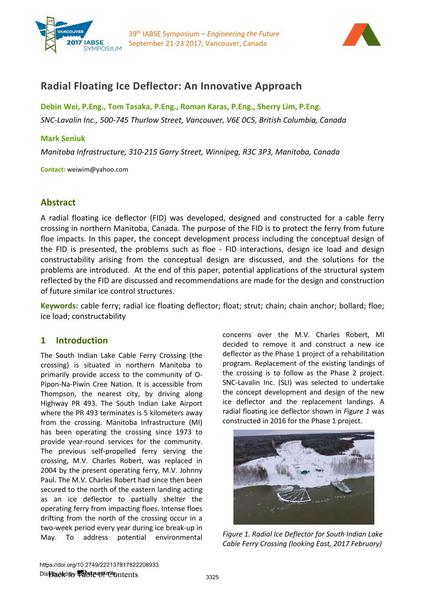Radial Floating Ice Deflector: An Innovative Approach

|
|
|||||||||||
Bibliografische Angaben
| Autor(en): |
Debin Wei
(SNC-Lavalin Inc., 500-745 Thurlow Street, Vancouver, V6E 0C5, British Columbia, Canada)
Tom Tasaka (SNC-Lavalin Inc., 500-745 Thurlow Street, Vancouver, V6E 0C5, British Columbia, Canada) Roman Karas (SNC-Lavalin Inc., 500-745 Thurlow Street, Vancouver, V6E 0C5, British Columbia, Canada) Sherry Lim (SNC-Lavalin Inc., 500-745 Thurlow Street, Vancouver, V6E 0C5, British Columbia, Canada) Mark Seniuk (Manitoba Infrastructure, 310-215 Garry Street, Winnipeg, R3C 3P3, Manitoba, Canada) |
||||
|---|---|---|---|---|---|
| Medium: | Tagungsbeitrag | ||||
| Sprache(n): | Englisch | ||||
| Tagung: | IABSE Symposium: Engineering the Future, Vancouver, Canada, 21-23 September 2017 | ||||
| Veröffentlicht in: | IABSE Symposium Vancouver 2017 | ||||
|
|||||
| Seite(n): | 3325-3332 | ||||
| Anzahl der Seiten (im PDF): | 8 | ||||
| Jahr: | 2017 | ||||
| DOI: | 10.2749/222137817822208933 | ||||
| Abstrakt: |
A radial floating ice deflector (FID) was developed, designed and constructed for a cable ferry crossing in northern Manitoba, Canada. The purpose of the FID is to protect the ferry from future floe impacts. In this paper, the concept development process including the conceptual design of the FID is presented, the problems such as floe - FID interactions, design ice load and design constructability arising from the conceptual design are discussed, and the solutions for the problems are introduced. At the end of this paper, potential applications of the structural system reflected by the FID are discussed and recommendations are made for the design and construction of future similar ice control structures. |
||||
| Stichwörter: |
Poller
|
||||
